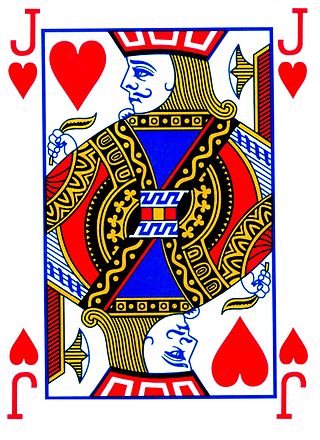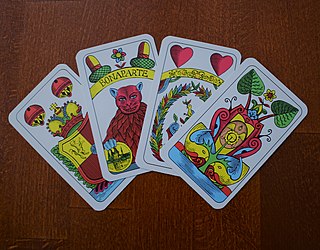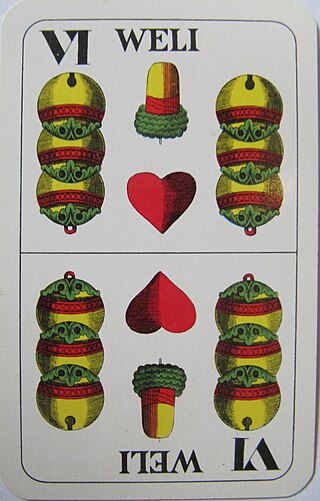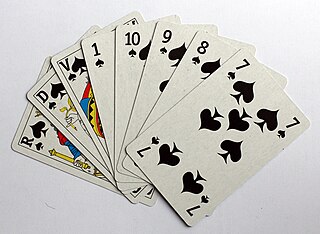
Reversis, or more rarely, Réversi, is a very old trick-taking card game of the Hearts group whose origin is supposed to be Italian, transformed into Spain and then in France. It is considered one of the two probable ancestors of Hearts, Black Lady and Black Maria, the other being Coquimbert or Coquinbert. It was very popular with the French aristocracy in the 17th and 18th centuries, and much played elsewhere, except in Britain. Initially quite simple, the game eventually developed into an elaborate affair involving vast quantities of counters and a complex system of pools and side-payments. Its name may have possibly come from the reverse order and construction of the game itself, or even from its exceptional slam which, like "shooting the moon" in Black Lady, reverses the entire aim of the game.

Rams is a European trick-taking card game related to Nap and Loo, and may be played by any number of persons not exceeding nine, although five or seven make a good game. In Belgium and France, the game of Rams is also spelt Rammes or Rems, in Germany, Rams, Rammes, Ramsch, Ramschen, Ramscheln or Ramsen, in Austria, Ramsen and Ramschen, and, in America, Rounce. The basic idea is fairly constant, but scoring systems vary. It was a widespread European gambling and drinking game that is still popular today. During the 19th century, it was introduced as Rounce in America and played with a 52-card deck without any difference between simples and doubles and with no General Rounce announcement. In the modern German variety of the game, Ramscheln, the 7♦ is the second best trump ranking next below the ace.
Elfern or Elfmandeln, is a very old, German and Austrian 6-card, no-trump, trick-and-draw game for two players using a 32-card, French-suited Piquet pack or German-suited Skat pack. The object is to win the majority of the 20 honours: the Ace, King, Queen, Jack and Ten in a Piquet pack or the Ace, King, Ober, Unter and Ten in a Skat pack. Elfern is at least 250 years old and a possible ancestor to the Marriage family of card games, yet it is still played by German children.

Bohemian Schneider is a card game for two people, which is played with a German-suited Skat pack of 32 cards. Because it is a simple trick-taking game, it is often played by older children and is recommended for age 8 upwards. It was probably developed in Bohemia and spread from there across the south German region and Austria. The game is sometimes called Bohemian Tailor, Schneider being German for "tailor".
Einwerfen or Zählspiel is a German 8-card point-trick game for four players in two teams of two and using a 32-card German-suited pack. Its closest relative is the popular Portuguese game Sueca. Perhaps the most basic and typical representative of the Ace-Ten card games, this game was first described as early as 1811, but may be considerably older.

Fünfzehnern is a simple, German, 8-card, no-trumps, point-trick card game for four individual players using a 32-card piquet pack. The game has a simplistic card-point schedule and unusual restrictions on leading to a trick.
Kontraspiel, also called Contra, is a German 5-card plain-trick game for four individual players using 24 cards. Eldest hand has the first right to accept or make trumps. The Unters of Acorns and Leaves are permanent highest trumps, the Wenzels. Kontraspiel is similar to the Scandinavian game Polskpas and is recorded as early as 1811.
Réunion, Reunion or Vereinigungsspiel is an historical German point-trick game for three players which, despite its French name, appears to have originated in the central Rhineland and lowland areas to the east. It is a 10-card game of the Ace-Ten family and uses a 32-card French-suited piquet pack or 32-card Skat pack. Players who cannot follow suit must trump. Otherwise the game can be described as a simplified version of Skat, but is also reminiscent of Euchre with its two permanent top trumps, the Right and Left Bowers.

Tippen, also known as Dreiblatt, Dreikart, Drei Karten, Dreekort, Kleinpréférence or Labet, is an historical German 3-card, plain-trick game which was popular as a gambling game for three or more players. The Danish version of the game was known as Trekort and more elaborate Swedish variants include Knack and Köpknack. It appears to be related to the English game of 3-Card Loo. It was banned as a gambling game in some places.

German Schafkopf is an old German card game and the forerunner of the popular modern games of Skat, Doppelkopf and Bavarian Schafkopf. Today it is hardly ever played in its original form, but there are a number of regional derivations.

Brandeln is an historical card game for four players in which three play against a soloist. It is one of the earliest games to use the terms Bettel – a contract to lose every trick – and Mord - a contract to win every trick. One of several card games mastered by Mozart, Brandeln is still current in Austria and Germany today. It has been described as having a "civilized, refined and ingenious character" and "one of the most pleasant card games".

Zwicken is an old Austrian and German card game for 4 to 6 players, which is usually played for small stakes and makes a good party game. It is one of the Rams group of card games characterised by allowing players to drop out of the current game if they think they will be unable to win any tricks or a minimum number of tricks. Despite a lack of sources, it was "one of the most popular card games played from the 18th to the 20th century in those regions of what is today Austria."

Belle, Flux et Trente-et-Un, is an historical, gambling, card game that was widespread in France and Germany during the 17th and 18th centuries. As a relative of Brag and Poch, from which the game of Poker developed, it is of cultural-historical interest.

Mauscheln, also Maus or Vierblatt, is a gambling card game that resembles Tippen, which is commonly played in Germany and the countries of the old Austro-Hungarian Empire.

Mistigri, historically Pamphile, is an old, French, trick-taking card game for three or four players that has elements reminiscent of poker. It is a member of the Rams family of games and, although it is a gambling game, often played for small stakes, it is also suitable as a party game or as a family game with children from the age of 12 upwards.
Bester Bube or Fünfkart is an historical German card game for 3–6 players played with a Piquet pack. It is one of the Rams group of card games characterised by allowing players to drop out of the current game if they think they will be unable to win any tricks or a minimum number of tricks. It may be an ancestor of Five-Card Loo.
Pollack is a German card game for four players in two teams of two that resembles the Italian game of Tresette, the aim being to score as many points as possible by taking tricks containing point-scoring cards and by announcing certain hand combinations as bonuses. According to Gööck, new players quickly realise that there is quite a lot to it and only those who stay alert get opportunities to score. The game is named after a bonus for holding its three top cards: the Ten, Nine, and Ace of one suit.

Vieux garçon is a card game played with a standard 52-card pack from which the jack of clubs is removed. It is a game for two to eight players. It is of the same family as old maid and Black Peter.

Culbas or Cul-bas is an historical French card game of the fishing type for three to eight players that dates to at least the 17th century. It is described as being "very old" and having "a great simplicity in which chance plays the biggest role."

Sizette is an historical French card game for six players in two teams of three. It is unusual in that communication between partners is allowed and the team captain is permitted to ask for information and direct play. It has been described as one of the most enjoyable games of cards, albeit one requiring skill to play well. It is a form of Whist for six players.















